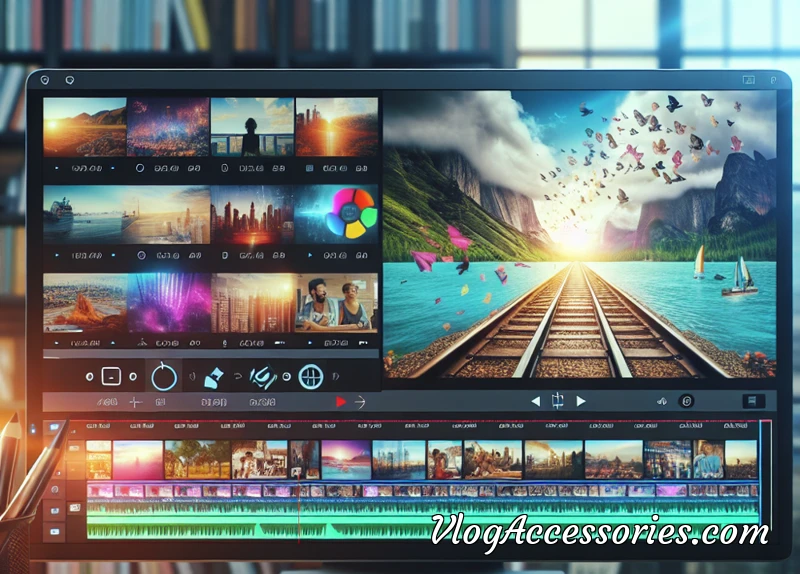Vlogging has become a popular form of content creation, allowing individuals to share their lives, experiences, and expertise with a global audience. Editing vlogs is a crucial step in creating engaging and professional-looking videos that keep viewers coming back for more. In this article, we will explore the essential tips and techniques for editing vlogs effectively.
Setting Up Your Editing Workspace
Before diving into the editing process, it’s essential to set up your workspace for maximum efficiency. Make sure you have a reliable computer or laptop with sufficient processing power and storage space. Invest in a high-quality monitor for accurate color grading and a comfortable chair to avoid fatigue during long editing sessions.
Choosing the Right Editing Software
There are several editing software options available, ranging from beginner-friendly to professional-grade tools. Popular choices include Adobe Premiere Pro, Final Cut Pro, and DaVinci Resolve. Choose a software that suits your skill level and budget, ensuring you have access to essential features like timeline editing, color correction, and audio enhancement.
Organizing Your Footage
Creating a Folder Structure
Start by organizing your raw footage into a logical folder structure to streamline the editing process. Create separate folders for each vlog episode, and further divide them into subfolders for video clips, audio files, music tracks, and graphics. This organization system will help you locate specific assets quickly and maintain a clutter-free workspace.
Logging and Labeling
Take the time to log and label your footage with detailed descriptions and timestamps. This step is especially crucial for vloggers who shoot multiple takes or cover various locations in a single video. By labeling your clips effectively, you can easily identify the best moments to include in the final edit.
Editing Techniques

Cutting and Trimming
Start by importing your footage into the editing software and arranging it on the timeline. Use the cutting and trimming tools to remove any unwanted sections, such as pauses, mistakes, or repetitive content. Keep the pacing dynamic and engaging by trimming clips to the essential moments that drive the narrative forward.
Adding Transitions and Effects
Enhance the visual appeal of your vlog by incorporating transitions and effects between scenes. Experiment with fades, wipes, and zooms to create smooth transitions that maintain viewer interest. Avoid overusing effects, as they can distract from the main content of your vlog.
Color Grading and Correction
Give your vlog a polished look by applying color grading and correction techniques to your footage. Adjust the brightness, contrast, saturation, and white balance to achieve a consistent and professional aesthetic throughout the video. Pay attention to skin tones and background colors to ensure a visually pleasing result.
Audio Editing
Removing Background Noise
Clean up your vlog’s audio by removing background noise, echoes, and other unwanted sounds. Use noise reduction tools in your editing software to enhance the clarity of dialogue and music tracks. Pay attention to audio levels and ensure that the sound is balanced and distortion-free.
Adding Music and Sound Effects
Select appropriate music tracks and sound effects to enhance the mood and tone of your vlog. Choose royalty-free music to avoid copyright issues and ensure that the audio complements the visuals without overpowering them. Use sound effects sparingly to emphasize key moments and transitions in your vlog.
Voiceover and Dialogue Editing
If your vlog includes voiceover or dialogue segments, pay special attention to editing these elements for clarity and coherence. Remove any mistakes, stutters, or background noise from the audio recordings to ensure a professional presentation. Adjust the volume levels to ensure that the voiceover is clearly audible against the background music.
Exporting and Publishing
Choosing the Right Export Settings
Before exporting your vlog, select the appropriate export settings to ensure optimal quality and compatibility with different platforms. Consider the resolution, frame rate, and file format that best suit your vlog’s content and target audience. Test the exported video on multiple devices to ensure that it looks and sounds good across various platforms.
Uploading to Online Platforms
Once you have exported your vlog, it’s time to upload it to online platforms like YouTube, Vimeo, or social media networks. Write an engaging title, description, and tags to attract viewers and improve the discoverability of your vlog. Share your vlog on social media and engage with your audience to build a loyal following.
Monitoring Performance and Feedback
Track the performance of your vlogs by analyzing metrics like views, watch time, and audience engagement. Use this data to refine your editing techniques and content strategy for future vlogs. Encourage feedback from your viewers and incorporate their suggestions to create vlogs that resonate with your audience.
Tips for Efficient Editing
• Create a storyboard or outline before starting the editing process to plan the structure and flow of your vlog.
• Use keyboard shortcuts and presets in your editing software to speed up repetitive tasks and streamline the workflow.
• Take breaks during editing sessions to avoid eye strain and maintain focus and creativity.
Conclusion
Editing vlogs is a creative and rewarding process that allows vloggers to bring their stories to life and connect with audiences worldwide. By following the tips and techniques outlined in this article, you can enhance the quality and impact of your vlogs, turning them into compelling and engaging videos that keep viewers coming back for more.